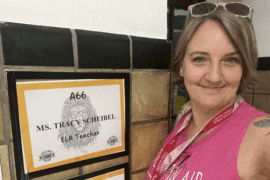10 Steps to Maximizing Your First Day Back to School
This will be my 16th year as a teacher. Even with years of September experiences, I still approach the first day of school with the same nervousness as my very first. I have learned that every year is different, every group of students unique, and behind each new student’s face, there is a story waiting to be told. I will have trouble falling asleep the night before school starts as I anticipate the mysteries of the first day. But, through the years I have tried and perfected some great first day of school activities. While it provides a fun day for all, it also gives me important clues about each of my students and begins the school year with rules, expectations, excitement, and anticipation. Here’s a sneak peek at 10 steps to maximizing your first day back to school and some of the things that will be filling my first days’ agenda!
- SMILE!
Seems obvious, right? Many of our students are coming in nervous! They are curious about you, your classroom, and your teaching. Calm their nerves with a smile, and smile all day long. I believe that teaching content is contingent on a student trusting you, and knowing that you care about them. First impressions are important. Begin laying that groundwork on day one by greeting each student with your best smile at the door. What else? Read on!
- Make it a welcome party!
Why not? Students have mixed emotions on the first day of school. They are excited for a new year, curious about their new classmates, scared about their teacher, disappointed that summer has ended, and tired because the wake up alarm went off for the first time in months! These are YOUR new students- and this is YOUR classroom. Welcome these kids by showing them exactly what kind of a year YOU have planned for them! Charge your first day with excitement and set the tone right for the rest of the school year! It doesn’t take a lot of energy, time, or money from you. Buy some welcome balloons (check out your local dollar store), throw some confetti as they come through the door (cut up some construction paper), and play some fun music! You will capture their attention and have them excited about the new year with 5 minutes of easy work! Trust me, it is worth it to get this ¨buy in¨ from your students. They´ll be forgetting about their ¨summer is over blues¨ and on the edge of their seats wondering what you have planned for them!
- Break the Ice!
Now that your students have entered your room, it’s time to get to know each other. There are so many ice breakers to choose from, and I would encourage you to research and find one that matches your personality and teaching style. After all, part of these ice breakers should be the kids getting to know you, too! One of my go-tos is a ¨Get to Know You Bingo.¨ I create the bingo cards by filling the squares with things like: I went to camp, I am an only child, I play soccer, I have been in a play, I can play an instrument, etc. I make sure that some of the details are true about me- and some years, I have made ALL of the details true about me. To fill the cards, students walk around the room and talk to one another, Students may initial one square that is true about them on each student’s bingo card. I like this game because students get to know each other without having the pressure of standing in front of a class and talking. It is fun, low key, and focuses on completing a task as a team- exactly where I am going next with my first day.
- Teach community.
In my class, we work together as a class, and as small teams. I do not promote competition, I teach group success. We learn together, learn from each other, and help each other. We all come with strengths and weaknesses, which means sometimes we need help, and other times we offer help. This is something I explain a little as I give the kids their first group task. Research and think about your classroom to figure out something that fits you as a teacher, and your classroom needs. I keep my first task simple. I need to take attendance, but the kids are all over the room, I ask them to stand and put themselves in alphabetical order. I offer no other rules, ideas, or help. Then I step aside, and observe.
- Observe your students’ interactions.
Watch your students’ reactions and interactions as they move through the day and activities. They have so much behind them, stories that they may or may not tell you. Simple activities will quickly reveal your classroom leaders, your chatty students, potential behavior issues, and your quiet and unsure students. Watch what students volunteer for- who likes (and hates) to talk in front of the class, who volunteers to draw for a group, to organize, and who is sitting out on everything. Much of teaching is on your feet, but make sure to take time starting on day one to sit back and observe what is happening within your students’ interactions. My first activity provides an initial glimpse into these students, but I like to take a few minutes to learn a little bit more. On day one, we take our first test!
- Give a learning style test.
You can make this as formal or informal as you are comfortable with. There are great online tests, paper and pencil printables, kahoot versions, or discussion/survey. But- I do think it is important for you and the students to know how they learn. As teachers of multiple students, we should already be making our lessons applicable to multiple intelligences. Our lessons should include auditory, visual, and kinesthetic components. Discovering learning styles early on can help you to better plan groups, create better lesson plans, and help individualize approaches to certain students. Many students don’t know how they learn. Identifying how they learn can be key in their study habits, reading/note taking, and general classroom success Take some time to explain each of the learning styles to the students, and ways that they can use their learning style to better learn. This can be a lengthy activity/discussion. I like to follow a heavy activity like this with a lighter, more fun one, like a scavenger hunt!
- Try the “get to know your classroom” scavenger hunt!
I believe that students should have some unspoken freedoms in the classroom. They should be able to get scissors, tissues, or sharpen their pencil without asking. I set up permanent stations of art supplies, measuring stations, student supplies, and a basket of desk needs at each table group. Now, I could just tell the kids where the permanent stations are in my class, but they would probably forget, and it would not be as much fun! So, we play a game to find things that are commonly used in my classroom. I close this activity by letting them know about the freedom in my room to get these things as they need them- and to put them away, of course! This opens up a discussion about rules, which is next up on my first day list!
- Make a student/teacher contract.
Every classroom needs order and rules. We could give these rules to the students- or- we could let them be a part of the rule making. Ask the students what kind of a classroom they would like to be in. I hear the same things from students each year- they want to be treated with respect- from the teacher, and other students. Lead the students through a discussion and make 3-5 basic rules. Tell them what you want from them as students, and allow them to tell you what they want as students from you as a teacher. You will learn a lot about your students through this activity, but you will also motivate them to follow the rules: after all, they wrote them. Write the ¨contract¨ on large poster board and let every student sign it. You can give the final exciting signature, and then hang it in the room.
- Communicate your expectations.
Your expectations have probably already been expressed as you went through the day, especially in the contract activity. Be clear with what you want from your students. If you want them quiet when you are talking, don’t talk over them. Tell them, and show them what is acceptable, and not acceptable. Set up and explain consequences. Be consistent. While reminders and warnings are OK initially, follow through with whatever consequence you set up. Student will test your limits- and they all need to see that there are consequences on the other side. I often see an eager volunteer emerge on day one. Follow through gently, letting all the students see the lines that should not be crossed. Classroom management will be a nightmare if you are not clear with expectations, dos and don’ts early. Repeat them, model them, remind them, and follow through.
- Create a time capsule.
This is a fun way to close the first day. We know as teachers that the kids change so much between September and June.
There are some great online time capsules, paper and pen versions, or you can just write one yourself! This can be a quick project, or more in depth if you want to jump right in and start working on their writing or technology skills. Either way, kids love this activity! Collect them, and return them in June.
Jessica Cicalese-Kurtz, MA in k-12 Teaching and Technology, BA in k-8 Education, BS in Biology, Science and Engineering. Jessica is a middle school teacher at Toms River Schools, K-8 Science curriculum writer for Toms River Schools and Ocean County, an independent Science workshop creator and presenter, freelance writer.





